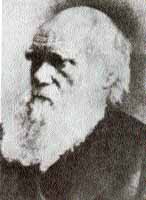| Chapter 13 PATAGONIA IN THE EYES OF CHARLES DARWIN |
|
|
Darwin was born in Serewsbury, England in 1809. His father and grandfather were physicians. After studing Medicine for two years in Edimburgh, he decided to quit and study teology in the University of Cambridge. It was thanks to one of his teachers there, the botanist Dr. Henslow, that Darwin got his interest in Natural Science back, especially in geology, botanics and entomology. It was also this clever teacher who advised Darwin to board the "Beagle" and join the Captain Fitz Roy expedition as a naturalist. The ten cannon ship baptized "Beagle" owned by the Royal Navy and commanded by Captain Fitz Roy finally sailed from Devonport in 1931 after failing twice because of the strong southwestern storms. The objectives of the expedition were to complete the studies of the coasts of the Patagonia and Tierra del fuego; to draw planes of the coast of Chile, Peru and some islands in the Pacific Ocean and last but not least to make a series of chronometric observations all around the world. Charles Darwin was part of this expedition. From the trip journal: The weather is dry and pleasant and the blue sky is rarely covered with clouds. All the attempts to colonize this coast of America at latitude 41° south have failed. |
The Patagonian fauna and flora is limited. Beetles are a common sight in the desert plateaus and sometimes a lizard shyly appears. There are also vultures flying across the blue skies and various insectivorous species can be found in the valleys. The wild "guanaco" or "llama" is typical in
this region. It may be called the Sotuhern American camel and is
commonly found in the warm lands of the continent as well as in
the cold islands near the Cabo de Hornos. Who may answer these questions? Everything that surrounds us seems eternal. However, the mysterious voices that are heard in these inmensities raise terrible doubts". Being back home and after getting married, Charles Darwin collected all his notes about the exploration and between 1840 - 1843 published them under the title of " Zoology of the trip to Beagle". In 1851 he also published some studies about "cirripedos", a special kind of marine crustacean. It was in 1859 that he finally published the work of twenty years: his very well known book entitled "The origin of the species". |
 The
simple name of "Puerto del Hambre" ( Hunger Port) is clear
enough to show the hard conditions that a few hundred of poor wretches
must have suffered. It is significant that not even one of those
men survived to tell their experience.
The
simple name of "Puerto del Hambre" ( Hunger Port) is clear
enough to show the hard conditions that a few hundred of poor wretches
must have suffered. It is significant that not even one of those
men survived to tell their experience.